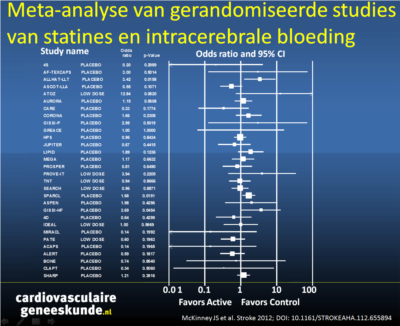Statinegebruik en het risico van intracerebrale bloeding: een meta-analyse
Literatuur - McKinney JS et al, Stroke 2012, May 16Statin Therapy and the Risk of Intracerebral Hemorrhage
- A Meta-Analysis of 31 Randomized Controlled Trials
McKinney JS, Kostis WJ.Stroke 2012 (Epub ahead of print; DOI: 10.1161/STROKEAHA.112.655894), May 16
Redactie: Commentaar Dr. Paul Brouwers, neuroloog Medisch Spectrum Twente
Analyse van SPARCL in combinatie met HPS heeft zorgen opgeroepen over een verhoogd risico op hersenbloedingen bij het gebruik van statines. Bij meta-analyses van de Cholesterol Treatment Trialists’ (CCT) Collaboration was nog sprake van een discrete trend en in een recente grote retrospectieve cohort studie van Hackam werd geen verhoogd risico meer aangetoond. In het voorliggende artikel wordt de grootse meta-analyse tot nu toe beschreven. In deze analyse wordt geen significant verschil meer gevonden (OR, 1.08; 95% CI, 0.88-1.32; p=0.47). Wel is het risico op beroertes en overlijden significant lager in de behandelde groep. Het risico op een hersenbloeding door het gebruik van statines lijkt hiermee definitief van de baan.
Achtergrond
Hypercholesteremia verhoogt het risico op een herseninfarct [1-5]. Lipidenverlagende behandeling met statines vermindert CV mortaliteit door het voorkomen van myocardinfarct en ischemische beroerte.Deze studie onderzocht het risico van hemorragische beroerte bij patiënten behandeld met statines, evalueerde het effect van statines op totale beroertes en mortaliteit door alle oorzaken, en bepaalde of hemorragische beroerte was gerelateerd aan veranderingen in LDL-cholesterol.
Alle beschikbare RCT's van statinetherapie waarin hemorragische beroerte werd gerapporteerd werden opgenomen in een meta-analyse.
Belangrijkste resultaten
- Statinebehandeling was niet geassocieerd met een verhoogde incidentie van intracerebrale bloeding (ICH) (OR, 1,08, 95% CI, 0.88-1.32, P = 0,47) (figuur 1).
- Er was geen relatie tussen het niveau van LDL-cholesterol en de effecten van behandeling op ICH risico.
- Totale beroerte was significant verminderd met statinebehandeling (OR, 0,84, 95% CI, 0.78-0.91, p <0,0001)
- De frequentie van de totale mortaliteit was significant lager in de statine-behandelde groep (OR, 0,92, 95% CI, 0.87-0.96, P = 0.0007)
 Figuur 1Forrest plot van random-effects meta-analyse van gerandomiseerde studies van statines en intracerebrale bloeding. Klik op afbeelding om te vergroten Download als Powerpoint, zie rechterkolom |
Conclusie
Statinetherapie was niet geassocieerd met een significant verhoogd risico van ICH. De aanzienlijke reducties in de totale beroerte en mortaliteit door alle oorzaken ondersteunen de aanbevelingen om statines in een ongeselecteerde patiëntenpopulatie voor te schrijven.
Referenties
1. Iso H, Jacobs DR Jr, et al. Serum cholesterol levels and six-year mortality from stroke in 350 977 men screened for the multiple risk factor intervention trial. N Engl J Med.1989;320:904 –910.2. Leppala JM, Virtamo J, et al. Different risk factors for different stroke subtypes: association of blood pressure, cholesterol, and antioxidants. Stroke. 1999;30:2535–2540.
3. Horenstein RB, Smith DE, Mosca L. Cholesterol predicts stroke mortality in the women’s pooling project. Stroke. 2002;33:1863–1868.
4. Zhang X, Patel A, et al. Cholesterol, coronary heart disease, and stroke in the Asia Pacific region. Int J Epidemiol. 2003;32:563–572.
5. Kurth T, Everett BM, et al. Lipid levels and the risk of ischemic stroke in women. Neurology. 2007;68:556 –562.
Abstract
Background and PurposeStatin therapy decreases the risk of ischemic stroke. An increased risk of intracerebral hemorrhage (ICH) has been observed in some studies. To investigate this issue, we performed a meta-analysis of randomized controlled trials using statins that reported ICH.
Methods
We performed a literature search of Medline, Web of Science, and The Cochrane Library through January 25, 2012, and identified additional randomized controlled trials by reviewing reference lists of retrieved studies and prior meta-analyses. All randomized controlled trials of statin therapy that reported ICH or hemorrhagic stroke were included. The primary outcome variable was ICH. Thirty-one randomized controlled trials were included. All analyses used random effects models and heterogeneity was not observed in any of the analyses.
Results
A total of 91 588 subjects were included in the active group and 91 215 in the control group. There was no significant difference in incidence of ICH observed in the active treatment group versus control (OR, 1.08; 95% CI, 0.88 –1.32; P=0.47). ICH risk was not related to the degree of low-density lipoprotein reduction or achieved low-density lipoprotein cholesterol. Total stroke (OR, 0.84; 95% CI, 0.78–0.91; P<0.0001) and all-cause mortality (OR, 0.92; CI, 0.87– 0.96; P=0.0007) were significantly reduced in the active therapy group. There was no evidence of publication bias.
Conclusions
Active statin therapy was not associated with significant increase in ICH in this meta-analysis of 31 randomized controlled trials of statin therapy. A significant reduction in all stroke and all-cause mortality was observed with statin therapy.

Deel deze pagina met collega's en vrienden: